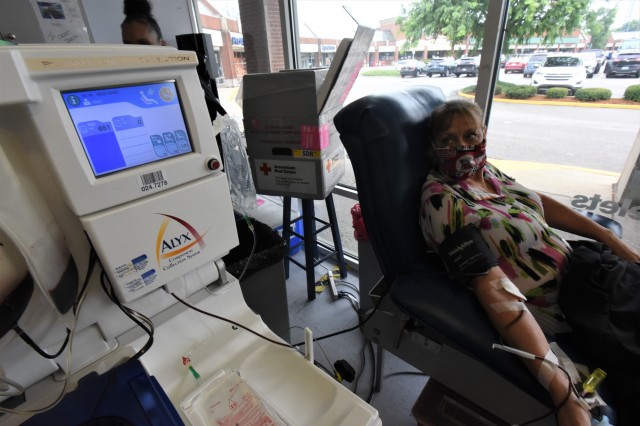
FORT KNOX, Ky. — For Wendy Steinhoff, the decision was easy.
A safety specialist from the Fort Knox Safety Office, Steinhoff said it was a recent doctor’s visit that started her on a path toward donating convalescent plasma to help treat others with COVID-19.
“I went in to see my doctor for something, and he asked me if I would be willing to do an antibody test,” said Steinhoff. “He came back and said that I have had COVID-19 before.”
Steinhoff said she was surprised to find out she had contracted COVID, especially since according to her doctor it was most likely sometime in December 2019.
“He was looking at my chart and said, ‘The only time you’ve been sick is back in December,’” she said. “Back then, I had asked him to give me something to help me sleep because I was coughing a lot when I laid down. So that’s when he thinks I had it.”
After discovering she had the antibody within her, Steinhoff’s doctor asked if she would consider donating plasma. She contacted Hardin Memorial Hospital; they pointed her toward the American Red Cross.
Steve Holton, collection specialist and a site supervisor for the East End Louisville American Red Cross Blood Donation Center, said they are the only facility in a 270-mile radius that can separate plasma from blood during the same visit.
Called apheresis, the process involves a separator machine that uses three bags to collect the plasma. The middle bag collects her whole blood, to include the red blood cells, platelets and plasma. The machine then separates it into red bloods in a second bag and plasma into the third bag.
When the machine collects 650 units of plasma, collection is complete. For Steinhoff, the collection process June 21 took about 20 minutes — the entire process lasted barely more than an hour.
Holton said convalescent plasma requests to combat COVID-19 started coming in about three months ago, after the Federal Drug Administration requested them. Since then, that center averages 16-30 donations a week.
“Researchers did a lot of testing, and they’ve been having a lot of success,” said Holton.
Successes have now resulted in the American Red Cross conducting an antibody test with every blood donation made at the center.
“We require that everybody comes in to donate blood first just to see if they have the COVID-19 antibodies,” said Holton. “If they are positive for the antibodies, we prefer them to be placed on this machine.”


When the plasma reaches St. Louis, officials there designate where the need is greatest.
Holton explained that those willing to donate their plasma can do so every 28 days. If they go through the Red Cross to schedule a donation, the site actually tells them where the donation goes to help others.
Steinhoff said she’s hoping to continue donating her plasma as long as the need is there.
“It’s a self-fulfillment for me,” said Steinhoff. “We should do our part to help other people whenever we can.”







Social Sharing